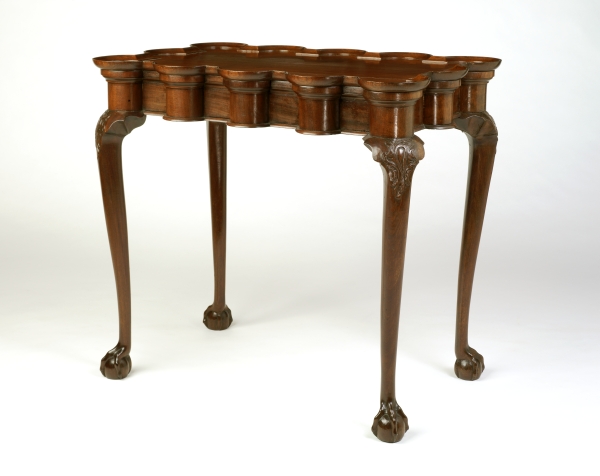· 6 ·
Boston Turret-Top Tea Tables
BROCK JOBE AND ALLAN BREED
In June 1934, during the height of the Depression, the New York antiques dealer Albert Collings called upon Hyman Kaufman, a long-time member of the trade in Boston. Collings recounted the visit in a letter to the noted collector Henry Francis du Pont: “he [Kaufman] showed me a small and very unique tea table that he said he had had over a year and never showed anyone as he paid a very high price for [it] and was going to hold it until conditions improved.” Collings noted that the table (fig. 1) is “blocked with small round blocks on all four sides and has round corners with cabriole legs and claw and ball feet, in the original untouched finish and not a missing part.” Although Kaufman expressed little interest in selling the table “under present conditions,” he would make an exception for du Pont, offering to send it on approval but noting that “he would have to get twenty thousand for it.”1 Du Pont responded: “I could no more think of paying twenty thousand dollars for this piece during these days than of flying to the moon.”2
FIG. 1. Tea table, Boston, 1755–65. Mahogany, white pine; h 27½, w 30, d 19⅜. Winterthur Museum; Bequest of Henry Francis du Pont (1958.2774).
Yet, du Pont’s curiosity was aroused. He wrote Kaufman that he would like to see the “marvelous” table and on August 27, 1934, met the dealer in Boston.3 Du Pont examined several items in Kaufman’s shop, but the table clearly made a strong impression. On a card, he scribbled the price and sketched the outline of the rounded projections of the tabletop. Later, in a note of thanks, du Pont agreed that the table was “unique.”4 The price was an obstacle, however, even for du Pont. The value of antiques had dropped precipitously. Desks that brought well over $1,000 in the late 1920s were selling for half that by the mid-1930s.5 As the Depression dragged on, it became harder for Kaufman to find a buyer; he eventually turned over his business to another Boston dealer, W. M. “Red” Jacobs.6 Yet du Pont never lost track of the table. Like most dedicated collectors, he always seemed to know where the prized pieces had gone. Five years after he had first learned of the table, he purchased it, paying $7,000.7
When describing the table, Collings, Kaufman, and du Pont all used the word unique, and indeed, among collectors, it was. The form had not appeared in the literature on antiques aside from a little-known publication of 1895, and no examples were on public display.8 Quickly, that was to change. Maxim Karolik turned up a slightly more ambitious model in 1940 and a year later gave it to the Museum of Fine Arts, Boston (fig. 2).9 The antiques dealer Henry Weil advertised another version in 1942, which Henry Flynt later bought for Historic Deerfield (fig. 3).10 In 1944, the Museum of Fine Arts received a second example through the bequest of a local resident (fig. 4).11 Within a year, one more came onto the market, this time through the dealer Israel Sack (fig. 5). He initially sold it to a Midwestern collector and, upon reacquiring it in 1951, placed it at Bayou Bend, the home of Texas collector Ima Hogg.12 Between du Pont’s purchase in 1939 and Sack’s first sale in 1945, five examples traded hands. Since then, only one more has emerged. In 1953, John Walton sold a comparable table to the New Jersey collector Dr. William S. Serri (fig. 6).13 Nearly forty years later, a variation of the form, with bowed ends rather than rounded projections, showed up in a Sotheby’s auction (fig. 7).14 In relation to the rest of the group, which comprises a tightly knit family of objects, the Sotheby’s table is a distant cousin.
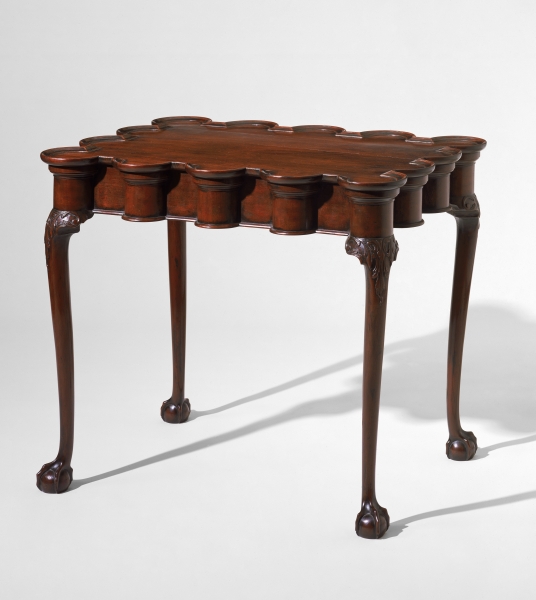
FIG. 2. Tea table, possibly Philadelphia area, 1935–40. Mahogany, white pine; h 27¾, w 32⅜, d 23⅜. Museum of Fine Arts, Boston; The M. and M. Karolik Collection of Eighteenth-Century American Arts (41.592). This table was sold to Maxim Karolik in 1940 as an authentic Boston tea table of the mid-18th century.
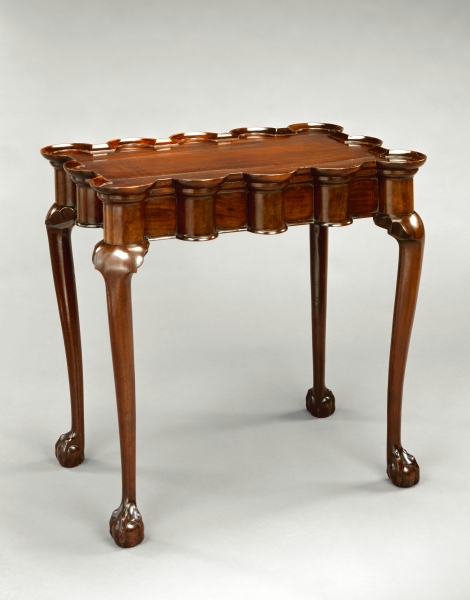
FIG. 3. Tea table, Boston, 1750–60. Mahogany, white pine; h 27½, w 30, d 19⅜. Historic Deerfield; Gift of Mrs. Helen G. Flynt (62.044).
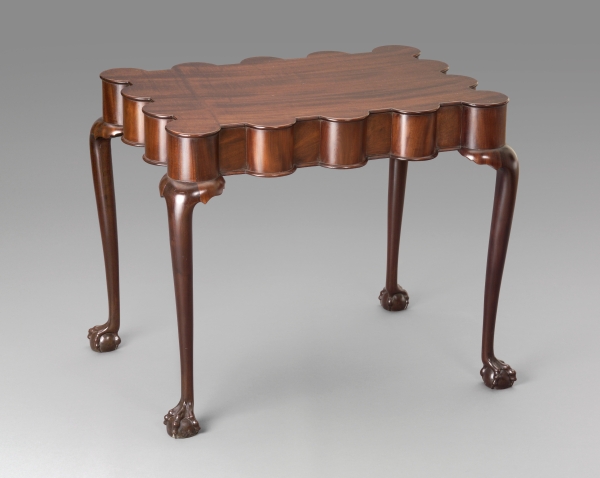
FIG. 4. Tea table, Boston, 1760–70. Mahogany, ash, white pine; h 26½, w 31, d 21½. Museum of Fine Arts, Boston; Bequest of Mrs. Mary H. Hayes (44.680). The top of this table originally had an applied rim.
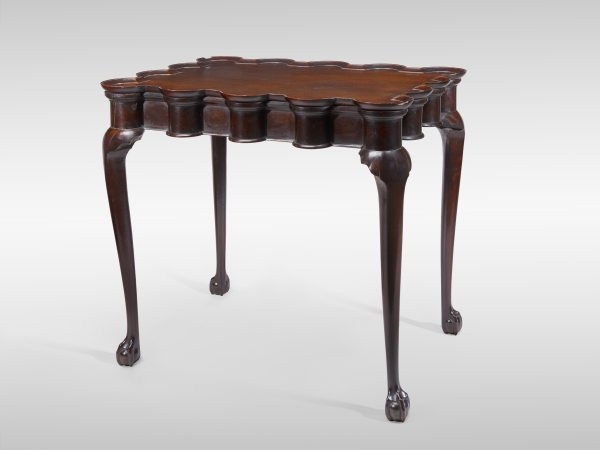
FIG. 5. Tea table, Boston, 1740–55. Mahogany, white pine; h 27¾, w 32⅛, d 23⅝. Museum of Fine Arts, Houston, Bayou Bend Collection; Gift of Miss Ima Hogg (B.69.362).
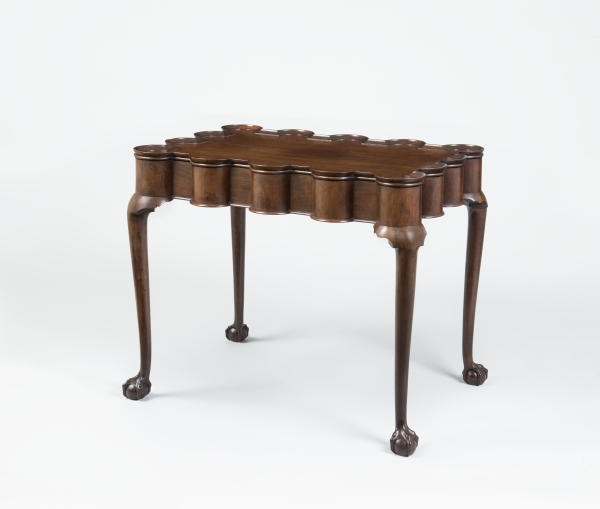
FIG. 6. Tea table, Boston, 1750–60. Mahogany, ash, white pine; h 26½, w 31, d 22¾. Private collection. Photo, Gavin Ashworth.
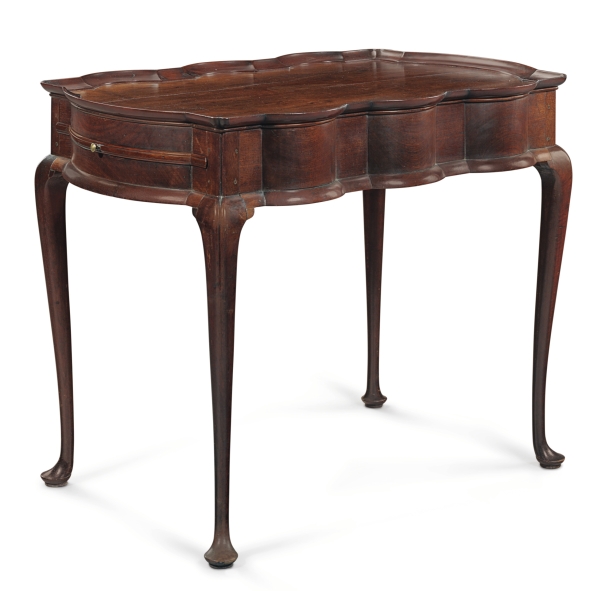
FIG. 7. Tea table, Boston, 1750–60. Black walnut, white pine; h 27, w 34⅜, d 22¾. Private collection. Photo, Christie’s.
The impact of this distinctive form has far outweighed its limited numbers. Since the 1950s, writers have praised the tables’ striking design and graceful proportions.15 Woodworkers of all stripes—from hobbyist to professional—have built hundreds of reproductions.16 Millions of visitors have seen examples of the form now on view at Winterthur, Bayou Bend, Historic Deerfield, and the Museum of Fine Arts. Yet these six tables have never received thorough study. Careful analysis sheds new light on the origin of the tables, their construction, and the sources of their design. Along the way, surprises emerge. The story begins by considering the use of these tables and of tea tables in general.
In eighteenth-century Britain, serving tea was a social ceremony, a mark of civility and welcome. American colonists embraced the pastime. In 1740, one visitor to Boston observed that “the ladies here visit, drink tea, and indulge every little piece of gentility, to the height of the mode; and neglect the affairs of their families with as good a grace as the finest ladies in London.”17 Family and guests gathered in the home around the tea table for conversation and refreshment (fig. 8). Most often the table occupied a prime position in the parlor. In 1743, for example, a Boston ship captain kept a costly “Mohogany Tea Table” in his “best Room.” Crowded onto the top were “10 China Cups & Saucers wth Tea Pott.”18 Unlike most tablewares, which were stored when not in use, tea china remained a permanent fixture on tea tables. Together the table and service symbolized refinement and fashion, offering the opportunity for polite conversation as well as entertaining gossip.
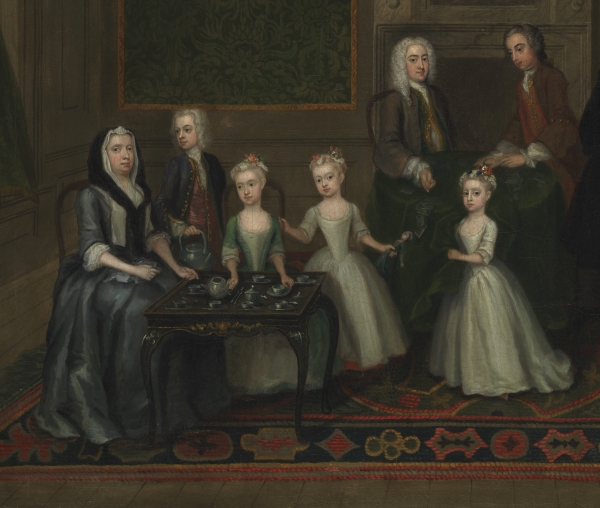
FIG. 8. Detail of The Strong Family, Charles Philips (1703–1747), London, 1732. Oil on canvas; h 29⅝, w 37. Metropolitan Museum of Art; Gift of Robert Lehman, 1944 (44.159).
The tea ceremony carried with it the hint of Eastern exoticism. The beverage came from China, and the tea wares often did as well. Even the rectangular table on which tea was frequently served owed its origin to China. Classic Chinese “half” tables, wine tables, and trays provided precedents.19 London cabinetmakers had adopted the form by the late 1720s, and their Boston counterparts were quick to follow.20 In some cases, local artisans constructed tables that closely followed British patterns (fig. 9). More often, they altered the design, typically by shaping the lower edges of the rails (fig. 10).21 Within this context, one maker chose to change the form dramatically by adding rounded projections to the top and semicircular turrets to the rails. The result was strikingly different from other tables and, among the colonial communities along the Atlantic coast, unique to Boston. The design must have attracted attention because of its distinctive outline; yet, a definitive name for the table has not turned up. Possibly it was the word scalloped, which eighteenth-century appraisers occasionally added to the description of a tea table in estate inventories.22 In the 1930s, Hyman Kaufman and Henry Francis du Pont preferred the term blocked. Twenty years later, writers adopted the word buttress, whereas more recent authors have chosen turret-top to characterize the form.23 Regardless of the designation, it is the shape of the table that not only sets it apart but also highlights its special attribute. The molded rim of the top defines the placement of cups and saucers, a feature recognized by one owner of the table now at Winterthur, who recalled in about 1910:
The table itself is unique. It was a tea-table. The outline of the top was a series of circular projections each planned to hold a tea-cup and saucer while still leaving room in the middle of the table for the other tea equipment. The entire table was edged with a narrow molding raised just enough above the surface of the table so that tea-saucers would not slide off if the table was jarred.24
What inspired this design? Did it arise from the creative genius of an inventive Bostonian? Or does it represent the efforts of a local artisan to copy an imported English example that he had seen? Was it the work of an immigrant who had made similar tables in Britain? Or might it reflect the wishes of a patron who had viewed a related table in his travels? Throughout the eighteenth century, nearly all Boston furniture fell within the mainstream of British design. Immigrant craftsmen, imported furniture, and pattern books such as Thomas Chippendale’s Gentleman and Cabinet-Maker’s Director all had an impact on local woodworkers. Within this setting, it seems most likely that the maker adapted an English form—but to what degree? Three sources may have influenced the maker.
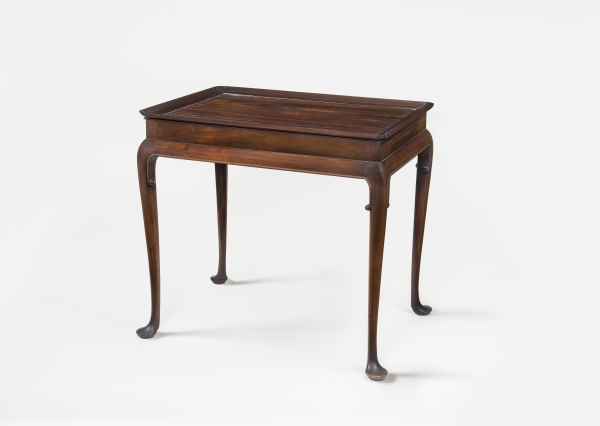
FIG. 9. Tea table, Boston, 1735–55. Mahogany, white pine; h 27, w 297/16, d 20¾. Gore Place; Purchased from the estate of S. Nash 1966, first loaned in 1942 (F.179). Photo, Gavin Ashworth.
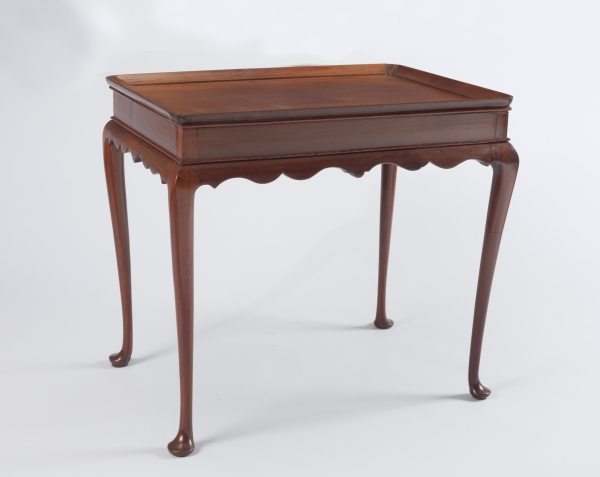
FIG. 10. Tea table, Boston, 1745–65. Mahogany, maple, white pine; h 267/16, w 29⅛, d 20¾. Historic New England; Gift of Caroline Barr Wade (1955.405).
English craftsmen produced trays and tilt-top tables with scalloped edges and a raised rim (fig. 11).25 On the latter, the top rested on a central pillar supported by three curving legs. In Boston, many had a plain circular top and were identified simply as “round” tea tables.26 However, one surviving Boston object, a small bottle stand at Historic Deerfield, echoes the outline of the British tables (fig. 12) and suggests the presence of imported items of this pattern in Boston.27 Perhaps they inspired the Boston maker to lay out his tabletops with similar rounded projections.
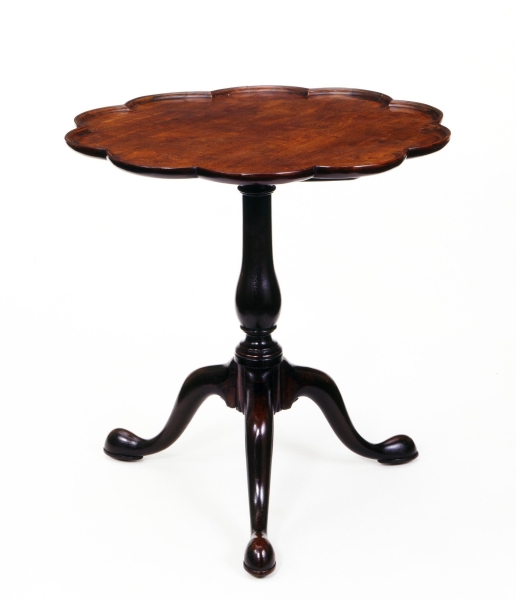
FIG. 11. Tea table, England, 1730–50. Mahogany; h 25¼, Diam 25⅜. Victoria and Albert Museum; Given by Douglas Eyre, in memory of his parents, Henry Richard and Isabella Catherine Eyre (W.30-1922).
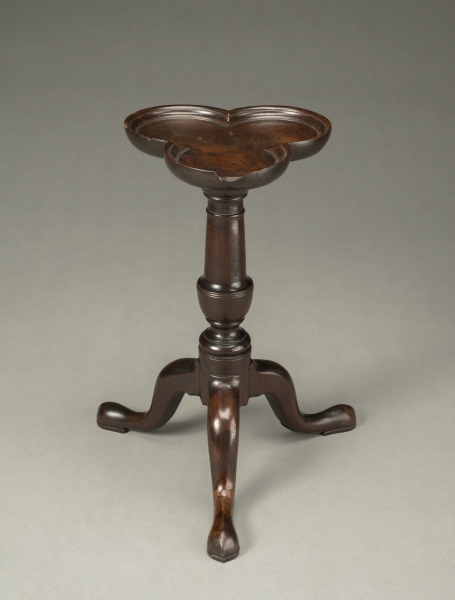
FIG. 12. Bottle or kettle stand, probably Boston, 1745–65. Mahogany; h 17½, w 13, d 9. Historic Deerfield (58.181). This object is said to have belonged to James Warren (1726–1808) and his wife, Mercy Otis Warren (1728–1814), of Plymouth, Mass.
Another British form may have played a more significant role. During the late 1720s, London cabinetmakers developed card tables with turreted corners. The folding top featured a circular pad at each corner for a candlestick, and the frame frequently had rounded blocks at the front corners that repeated the curves in the top.28 The table became a staple of the furniture trade; thousands were built and some surely made their way to Boston, where they could have served as precedents for local versions. Immigrant craftsmen such as William Freeland, an Irish joiner who arrived in 1730, could also have introduced this British design. Boston artisans readily adopted the form and produced stylish mahogany examples (fig. 13). In certain respects, the construction of the turreted corners of the card tables matches that of the tea tables. The person who built the first turret-top tea table may well have adapted the rounded corners and knee brackets from his design for card tables.
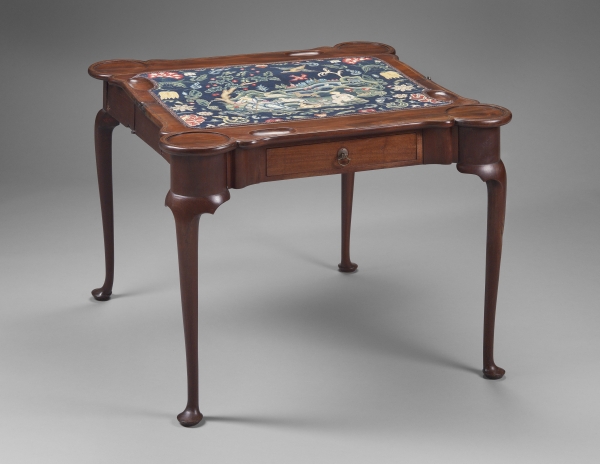
FIG. 13. Card table, Boston, 1730–50. Mahogany, chestnut, white pine; h 27, w 35⅝, d open 35⅛. Museum of Fine Arts, Boston; Museum purchase with funds donated anonymously and William E. Nickerson Fund (49.330).
One other source presents the most intriguing possibility. In 1983, an English japanned tea table surfaced at a country house sale in Kent (fig. 14). The pattern clearly relates to the Boston versions. A coincidence? Or might a Boston cabinetmaker have had access to an imported table of this design? Could the “Japan’d Tea Table” or the “India” tea table listed in Boston estate inventories of the 1740s have resembled the one sold in England?29 We lack proof of a connection, but the parallels are fascinating.
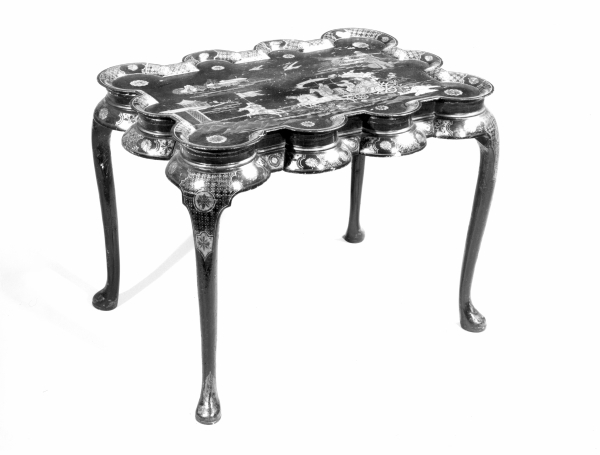
FIG. 14. Tea table, England, possibly London, 1735–50. Unidentified woods; h 25½, w 36, d 26. Present location unknown. Photo, Christie’s London. Sold by Christie’s at the sale of the contents of Godmersham Park, Canterbury, Kent: The Property of the Late Mrs Robert Tritton, June 6–9, 1983, lot 133. For a related table at Leeds Castle, Kent, see Mavis Henley, Leeds Castle (London: Philip Wilson, 1994), 54.
Regardless of his sources, the maker of the turret-top table blended and adapted elements into a new product that was unmistakably Boston. The small size and delicacy of the tea tables, together with their stiff cabriole legs and long, curving knee brackets, relate to similar features on other tables by local craftsmen (such as figs. 10 or 13).30 The presence of a common aesthetic among cabinet shops in Boston raises a question about the origin of the turret-top tables. Were they made by a single master or by multiple workmen in several shops? Construction details of each table divulge the answer.
The best preserved—and indeed best documented—of the tables is the one at Winterthur.31 When Henry Francis du Pont purchased it, he noted that it had come from the Sever family of Kingston, a village near Plymouth, Massachusetts. The original owners, William and Sarah Sever, probably acquired the table about the time of their marriage in 1755. It passed through several generations but remained in the Sever homestead, which became a veritable museum for the family members who summered there. A photograph of about 1910 depicts the table and other antiques in the parlor of the house (fig. 15). During the Depression, the family began to sell a few items. The tea table was one of the first to go, when George and Frank Sever, great-great-grandchildren of the original owners, offered it to Hyman Kaufman around 1931.32
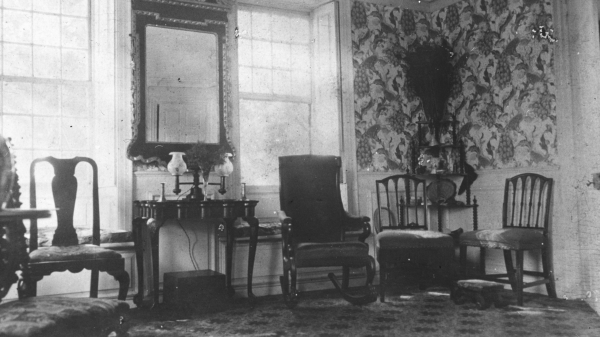
FIG. 15. Parlor of the Sever house, Kingston, Mass. Photograph, ca. 1910. Courtesy of the Jones River Village Historical Society and the Kingston Public Library Local History Room.
Since arriving at Winterthur, the table has received careful study on several occasions. A particularly revealing analysis occurred in 1983 during conservation of the frame. The legs had become loose and one needed to be removed and reattached. Once the corners of the frame were exposed, dovetails could be seen, rather than the expected mortise-and-tenon joints (fig. 16). More recently, X-rays showed that the legs are attached to the corner turrets with round tenons (fig. 17). A picture of the table’s construction emerged. With this evidence and additional investigation, Allan Breed sought to identify and replicate the steps that the maker and his workmen might have followed in building the Sever family table. Distinguishing the work of the master from others’ in the shop is all but impossible. The following account presents our approximation of the process.
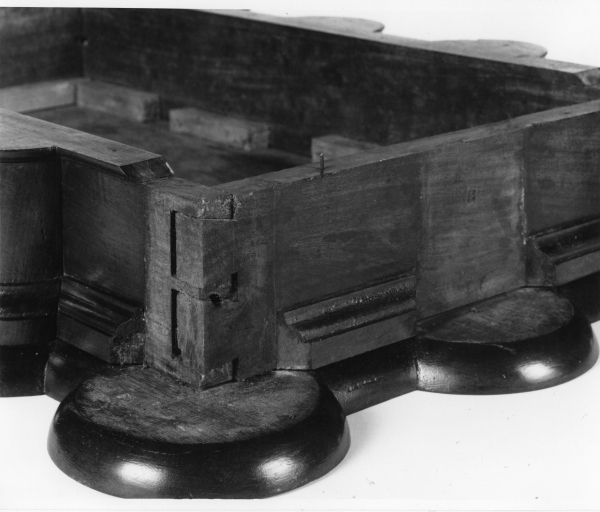
FIG. 16. Detail of the Winterthur tea table in fig. 1 during conservation in 1983.
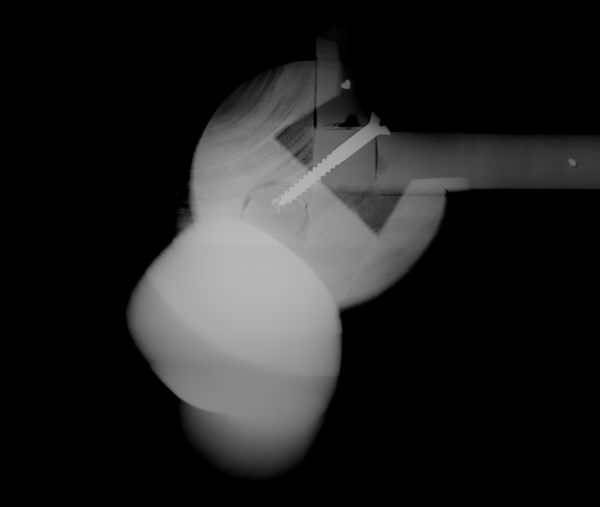
FIG. 17. X-ray of the Winterthur tea table in fig. 1, showing round tenon that joins leg to turret.
The maker began by choosing dense, straight-grained mahogany of excellent quality. For the frame and the top, he selected stock of just under an inch in thickness. He fashioned the top and rim from a single solid board; the rim is not applied. He used a compass to lay out arcs for the turrets and reduced the area inside the rim with gouges and scrapers. The finished top was simply set on the frame and secured with pine blocks glued to the rails and underside of the top. To tighten the overall table, he drove small brads through the top into the turrets.
The construction of the legs and turrets reflects both standard Boston practice and innovative solutions. Using patterns as a guide, the maker traced the outline of each leg onto three-inch square stock and sawed the legs into thick cabrioles. He set the sawn leg on a lathe and turned a pin at the top measuring one inch in diameter. He next glued roughly shaped brackets to the knee and repositioned the leg on a lathe and turned the knee and brackets. To complete each leg, he worked the cabriole to final shape with multiple tools, probably including a draw knife, spokeshave, scrapers, and rasp. At this point, he could have entrusted the carving for the foot and knee to a specialist, but given the routine pattern of the feet and coarseness of the knees, it seems more likely that he performed the task himself.
To make the half-round turrets, the maker glued together two blocks, separated by a slip of paper (or possibly a thin strip of pine), and turned the larger block into a cylinder on a lathe. He split apart the glue joint with a chisel and later glued each half-round block to the rails. The corner turrets required nearly four-and-one-half-inch square stock. A quadrant was cut away and replaced with inexpensive pine; again, paper provided a layer of separation between the two woods. The maker turned the block to its final size and drilled a hole in it to receive the top of the leg. The secondary wood was removed. He then attached the leg and turret with a round mortise-and-tenon joint and eventually glued the leg assembly to the dovetailed corner of the rails. As a final step, he glued short pieces of molding with mitered edges to the frame between the turrets and just beneath the top and nailed flat strips with a beaded outer edge to the underside of the rails.
The Sever table represents an inventive twist on the typical Boston tea table. When building his replica, Allan Breed noticed many variations from the norm. The lathe-turned turrets and solid top with a carved (rather than an applied) rim distinguished the table from most Boston examples, such as the one in figure 10. Less visible but just as distinctive were the dovetailed frame and round tenon joining each leg to a corner turret. Breed was surprised to discover that the maker of the Sever table had used only glue to secure each corner turret and leg to the frame. These glue joints had loosened over time, prompting the addition of screws into the corners of the table, possibly as early as 1800.33
Among the other turret-top tables, the one at Historic Deerfield (see fig. 3) matches the Sever table in nearly every detail. Both have the same number of turrets and conform almost exactly in size. Their turrets are identical in design, capped with the same turned ogee and fillet at the top. Their construction corresponds, from the carved rim of the top to the dovetailed frame and round mortise-and-tenon joint fastening the leg and turret. On the underside of the feet of the Deerfield table, two center points are visible (fig. 18): one for turning the round tenon at the top of the leg, the other for laying out the claw-and-ball feet. Similar points were undoubtedly present on the feet of the Sever table, but evidence of them disappeared when casters were mounted onto the feet and later removed.34 Only the absence of knee carving on the Deerfield example separates the two tables. A single maker must have built them, probably within two or three years of each other.
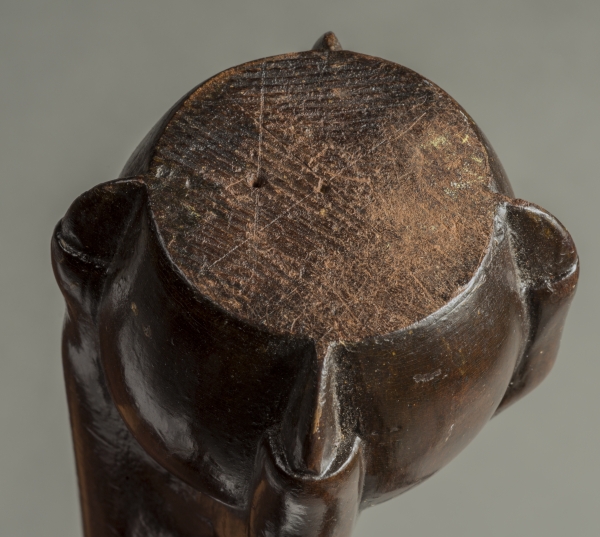
FIG. 18. Underside of foot of the Historic Deerfield tea table in fig. 3.
One minor feature of the Deerfield table suggests that it was constructed first. The claw-and-ball feet follow an earlier pattern, featuring a broader web between the claws and a blockier outline to the claws (figs. 19, 20). Regrettably, the Deerfield table lacks a compelling, documented history to support the visual evidence; only a sketchy and confusing provenance survives. One twentieth-century account links the table “to the Winslow-Pierce family in New Hampshire,” while another notes that it “was found near Duxbury.”35 The latter community bordered the Severs’ hometown of Kingston, a tantalizing fact but one that has yet to yield further information about the Deerfield table or its date of construction.
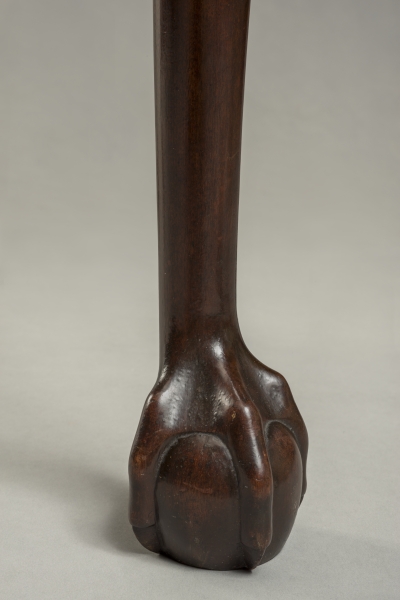
FIG. 19. Claw-and-ball foot of the Historic Deerfield tea table in fig. 3. This foot, like most early versions of Boston claw feet, displays a broad web between the upper portion of the claws.
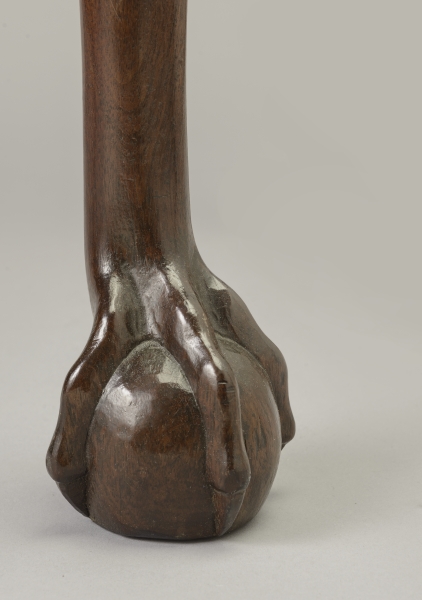
FIG. 20. Claw-and-ball foot of the Winterthur tea table in fig. 1. This foot, like later Boston claw feet, lacks a noticeable web across the claws.
A third table with a stronger provenance (see fig. 5) shares many features with the Winterthur and Deerfield examples. Acquired by Bayou Bend in 1951, the table had belonged a half century earlier to Frederick Beck (1818–1909), a Boston-area banker, import merchant, and investor in copper mines in Michigan. Beck filled his home in Brookline with antiques (fig. 21), some of which he inherited from his sister Sarah Phillips Beck (1816–1902), who had “valuable old carved furniture,” along with “curious and rare china” in her house in Cambridge.36 The tea table apparently never left the Boston area until sold by the Beck family to the antiques dealer Israel Sack sometime before 1945. In its basic outline, the table differs from the Sever and Deerfield examples only in size. With fourteen turrets rather than twelve, the table is two inches longer and almost four inches wider than its counterparts. A close look, however, reveals more subtle distinctions. The legs are stiffer and the knees less pronounced. The feet are surprisingly small and the claws less defined than those on other turret-top tables (fig. 22). In construction, the Beck table follows the Sever and Deerfield examples, with one important variation. Instead of a series of dovetails at the corners of the frame, each rail is fastened to a turret with a single sliding dovetail (fig. 23). The joint proved to be a weak one, and reinforcing blocks and screws were soon needed. The sliding dovetails set the Beck family table apart; yet, in so many other features—the solid top and rim, shape of the turrets, and round-tenon joint fastening the leg to the turret—it parallels the other two tables. A single maker may well have crafted all three. If so, he probably built the Beck family table first. Here he may have experimented with sliding dovetail construction, found it insufficient, and switched to a different method for later tables.37 The small, embryonic claw feet reinforce the possibility of an early date. Though unusual, they relate more closely to Boston patterns of the 1740s than to later ones.
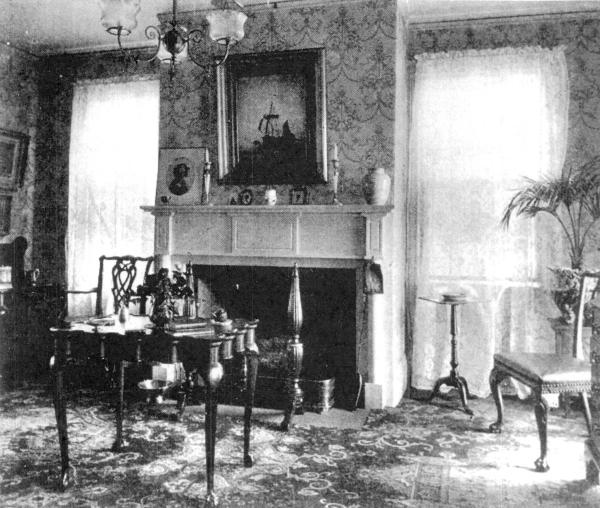
FIG. 21. Drawing room of Frederick Beck house at 48 Davis Avenue, Brookline, Mass. From Charlotte Reeve Conover, A History of the Beck Family (Dayton, Ohio: privately printed, 1907), 85.
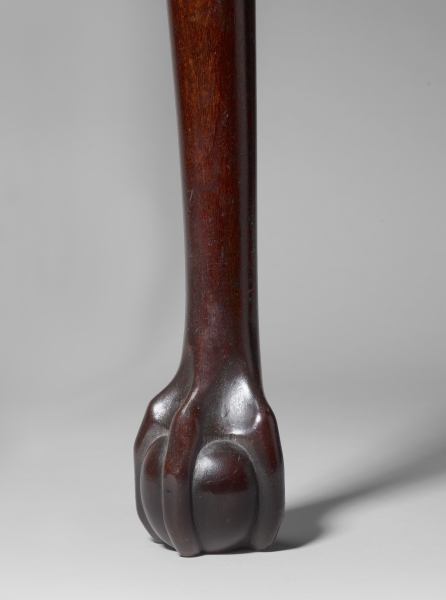
FIG. 22. Claw-and-ball foot of the Bayou Bend tea table in fig. 5.
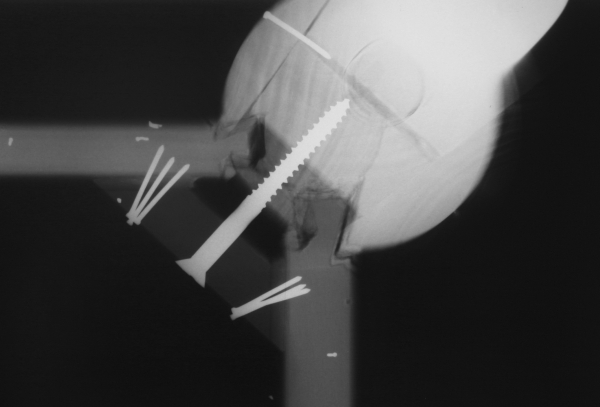
FIG. 23. X-ray of the Bayou Bend tea table in fig. 5, showing sliding dovetails that join rails to a corner turret. Also visible is the round tenon that joins the leg to the turret.
The similarities of the preceding three tables become even more apparent when comparing them to two other turret-top examples (see figs. 4, 6). Though the latter two resemble the others in general outline, their construction sets them apart. The flat top of one table (fig. 4), now at the Museum of Fine Arts, Boston, readily distinguishes it from the others. It originally had an applied rim, which probably resembled that on a related table in a private collection (fig. 6).38 On both tables, the top is extremely thin, measuring less than one half inch thick, and the outer edge of the top forms a beaded edge visible beneath the rim.
Close inspection reveals other differences as well. On the first three tables, the corner turrets are made of solid mahogany. On the other two, these elements consist of a secondary wood veneered with mahogany. Instead of a frame formed of rails dovetailed at the corners (see fig. 16), the rails of the two tables are tenoned into the corner turrets (fig. 24). In addition, two vertical triangular blocks are glued at each corner of the frame. Lastly, the individual turrets are broader and more pronounced but simpler in shape, without the decorative ogee and fillet that adorns the top of the turrets on the first three tables. Could both be the work of a second, unidentified shop? Possibly, but two attributes may instead indicate that each is the work of a separate maker. A construction detail offers the first clue. On the first three tables, a round tenon links leg and turret. By contrast, the privately owned table relies on a large sliding dovetail (fig. 25), much like that on numerous Boston turreted card tables.39 The second table displays a more unusual technique. The outer face of the turret is cut in a quarter-round shape to receive the upper end of the leg (see fig. 24). Both the sliding dovetail and quarter-round extension are covered by veneer, only apparent through X-radiography or the removal of the top.
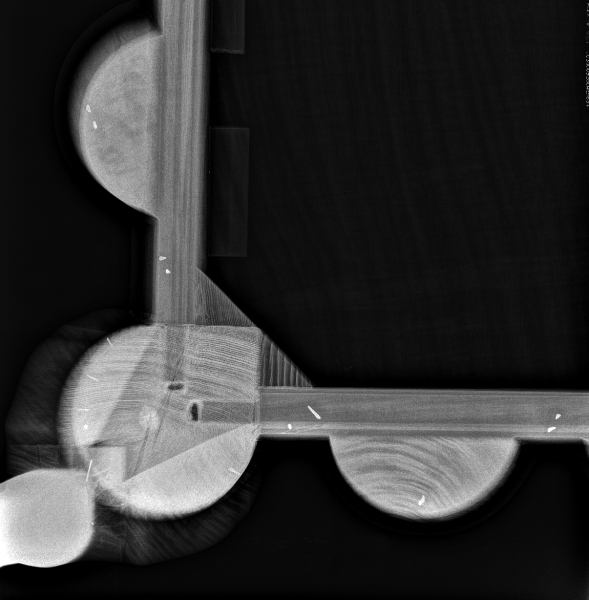
FIG. 24. X-ray of the Museum of Fine Arts, Boston, tea table in fig. 4, showing tenons that fasten rails to the corner turret. Also visible is the quarter-round end of the leg that fits into a corresponding notch in the turret.
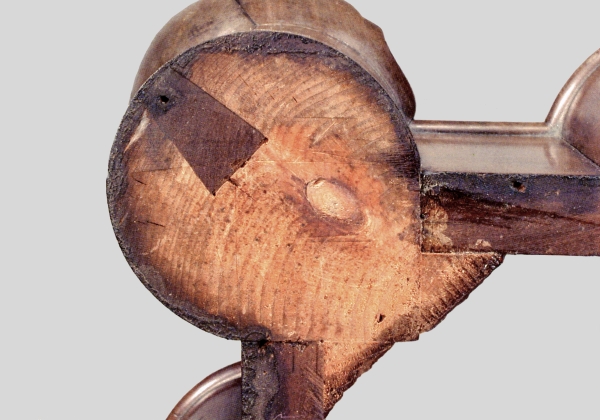
FIG. 25. Detail of a corner turret of the private collection tea table in fig. 6, showing sliding dovetail that fastens the leg to the turret. During a thorough assessment of the table in 2004, the conservator Robert D. Mussey Jr. removed the top and photographed the table’s construction.
A second feature is more visible. The carved feet of the privately owned table have a broad web across the upper portion of the foot, and the claws descend straight down over the ball (fig. 26). On the other table, the knuckles of each claw are much more pronounced, and the side claws rake back in the manner often seen on Boston claw-and-ball feet of the 1760s and 1770s (fig. 27).40 The variations in foot design suggest two different periods of construction. In all likelihood, the privately owned table was made in the 1750s, the other in the 1760s. The history of the later table lends further credibility to its date. Bequeathed to the Museum of Fine Arts, Boston, in 1944 (see fig. 4), it can be traced back to the nineteenth-century will of Susan Mitchell Hall Fitch of Medford, Massachusetts, just west of Boston. Fitch described the table as “1 Mahog. Scalloped table. Grandmother Jones of Weston.”41 This likely refers to Mary Jones (ca. 1733–1820), who married Isaac Jones (1728–1813), a prominent Tory merchant and innkeeper in Weston, Massachusetts, on March 4, 1762. They might well have acquired the table about the time of their wedding. Among their other possessions were a set of Boston chairs and blockfront desk and bookcase.42
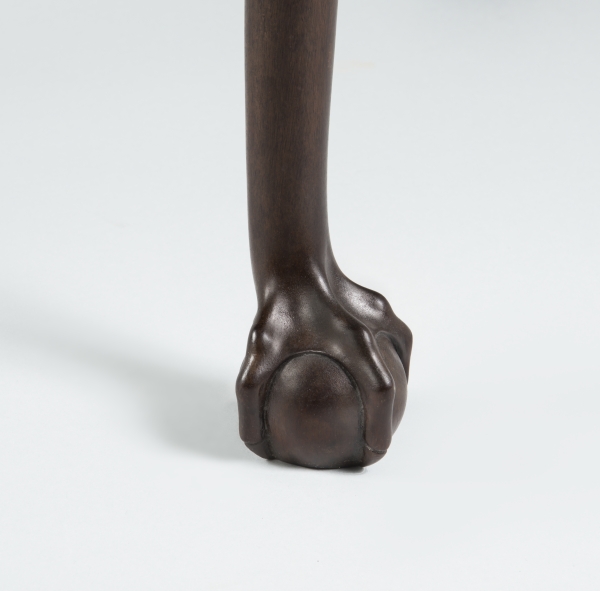
FIG. 26. Claw-and-ball foot of the private collection tea table in fig. 6.
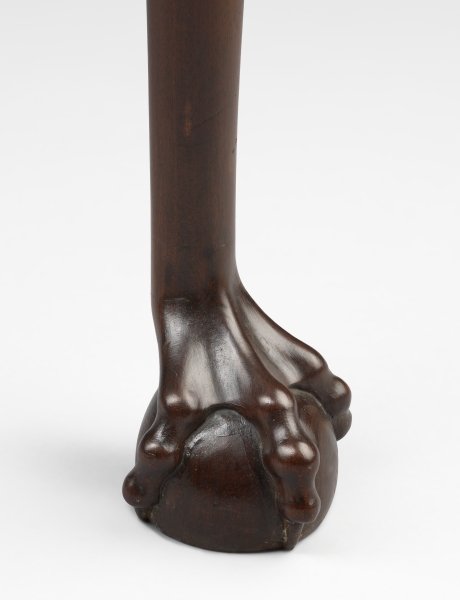
FIG. 27. Claw-and-ball foot of the Museum of Fine Arts, Boston, tea table in fig. 4.
A final turret-top table takes our story of this distinctive form in a new direction. During the 1930s, the noted Boston collector Maxim Karolik assembled a major collection of American furniture, which he subsequently gave to the Museum of Fine Arts in 1941. One of his most prized acquisitions was a turret-top tea table (see fig. 2). In its petite proportions, spirited knee carving, gracefully shaped legs and feet, and pristine condition, it ranked as the finest example of the form. But was it too fine? Too good to be true? A thorough assessment in 2012 raised many questions. These fall into four categories: condition, construction, finish, and carving. The condition of the table is perfect. From the rim of the top to the tips of the feet, there are almost no signs of wear. Every element is still in place, including all twelve original support blocks beneath the top (fig. 28). In itself, superb condition does not condemn an object. A surprisingly large amount of the best colonial furniture has survived in an exceptional state of preservation. However, it does raise a cautionary flag and beg a closer look.
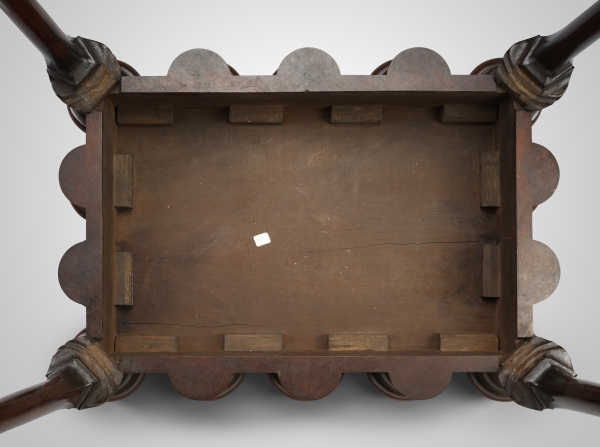
FIG. 28. Underside of top of the Museum of Fine Arts, Boston, tea table in fig. 2.
At first glance, the table’s construction conforms to eighteenth-century practice. It matches in nearly every detail the techniques evident in the Winterthur and Historic Deerfield examples. Careful scrutiny reveals three key exceptions. First, the leg is attached to the turret with a square tenon (fig. 29). Although this joint is acceptable for the period, it stands out in contrast to the round tenons used on three other turret-top tables.43 Second, each leg and adjoining knee brackets are solid; customarily, the brackets are separate elements glued and nailed to the leg. The practice permitted the colonial maker to use thinner stock for the leg, a cost-cutting measure consistent with traditional woodworking. Lastly, the Winterthur and Deerfield examples have ogee moldings set just beneath the top and between the turrets. The maker of the Karolik table omitted this detail, perhaps because of the difficulty in cutting and mounting the moldings. Again, none of these features alone is sufficient to cast doubt on the table, but collectively they raise concerns.
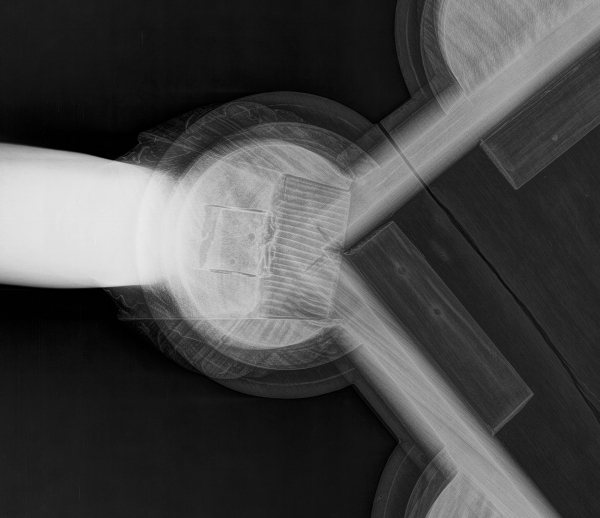
FIG. 29. X-ray of Museum of Fine Arts, Boston, tea table in fig. 2, showing square tenon that joins leg to turret.
Study of the finish provides little reassurance. The underside of the top, support blocks, and frame is covered in a milky red wash, obscuring the aged, unfinished surfaces that one hopes to see (see fig. 28). The rich, darkened color of centuries-old white pine support blocks and a mahogany frame cannot be found, calling into question whether such color was ever present. Elsewhere on the table, the finish causes further unease. An opaque black stain fills the crevices around the carving on the knees and feet (fig. 30). Although the periodic application of finish and polish on colonial furniture can soften carved edges and leave a darkened residue, in this case someone has conspicuously colored the carving, apparently to imitate an antique surface.
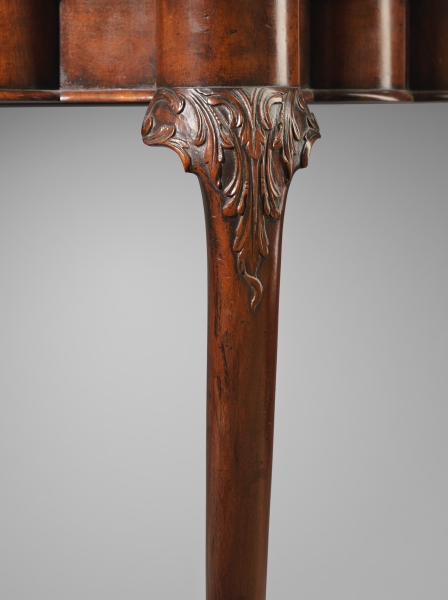
FIG. 30. Knee carving of the Museum of Fine Arts, Boston, tea table in fig. 2.
The character of the carving strikes a final troubling note. The flattened balls of the feet and articulation of the claws follow a Philadelphia pattern, rather than a Boston model.44 Likewise, the design of the knee carving reflects the hand of someone more familiar with Philadelphia furniture than that of Boston. The carver cut the acanthus leaves more deeply and imbued the layout with more animation and naturalism than did Boston craftsmen, whose work by comparison looks stiff and stylized.45 Furthermore, on the Karolik table, the carver lapped leaves over one another and, at the lower end of the knee, curled the tip of a leaf onto itself—all details associated with Philadelphia rococo furniture.
The evidence seems overwhelming. Maxim Karolik acquired a fake, a table made to appear old with the intent to deceive. To better understand what happened, two other Karolik acquisitions deserve mention. In 1939, Karolik bought and immediately lent an ornately carved Philadelphia side table and tilt-top tea table to the Museum of Fine Arts. Both became gifts in 1941 and were published by Edwin Hipkiss in his catalogue of the Karolik collection.46 By 1974, however, questions had arisen about the authenticity of the tables. The respected dealer Albert Sack deemed the tea table to be a reproduction, and soon both pieces went into storage. In 2002, after examining the tables, the furniture scholar Luke Beckerdite concluded that they were the work of the same hand and, going a step further, suggested that this individual had also carved Karolik’s turret-top table. Indeed, a close look at the knee carving of the side table (fig. 31) and Karolik’s turret-top table (see fig. 30) substantiates Beckerdite’s claim.47 The curving spiny leaves flanking the central leaf are remarkably similar. The series of gouge cuts that form a string of beads in several locations are the same. The carving is outlined with a black stain. One could easily believe that both legs were carved by the same person.
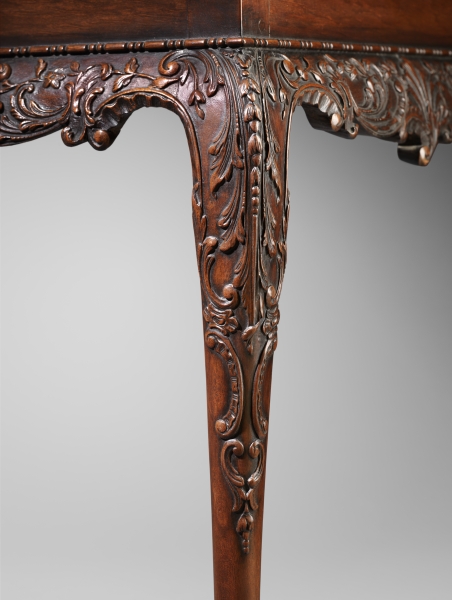
FIG. 31. Knee carving of side table, Philadelphia area, 1930–39. Mahogany, marble; h 28¼, w 42, d 23½. Museum of Fine Arts, Boston; The M. and M. Karolik Collection of Eighteenth-Century American Arts (41.589). This table was sold to Maxim Karolik in 1939 as an authentic Philadelphia table of the mid-18th century.
The provenance of the turret-top table reinforces a possible connection to the other two fakes. Karolik acquired all three from a single source, William M. “Red” Jacobs. This same dealer supplied a pair of rococo marble-top tables to another Boston collector in 1944 that were later deemed to be fakes.48 According to one source, Jacobs had a checkered reputation, but authentic pieces did pass through his hands.49 It was Jacobs who sold the Sever tea table to Henry Francis du Pont in 1939. Did Jacobs decide to double his investment by commissioning a cabinetmaker to create a grander version of the Winterthur table? A Sever descendant recalls that Karolik had seen the Sever table before du Pont bought it but chose not to pursue it.50 Perhaps Karolik disliked the coarse knee carving or balked at the sales price. Imagine his pleasure in discovering a version with fourteen turrets rather than twelve and far more appealing acanthus leaf carving—and finding it available at a lower price.51 The purchase made sense. It was the perfect table, had it only been genuine.
Who might Jacobs have engaged to make the table? Almost certainly it was, as Luke Beckerdite suggested, the same person who fabricated the marble-top and tilt-top tables in the Karolik collection. The maker understood eighteenth-century Philadelphia furniture and likely resided in the Philadelphia area. With that in mind, one name has surfaced: Emil Dill (1890–1954). Trained as a cabinetmaker in Germany, Dill arrived in the United States in 1912 at the age of twenty-two and eventually established his own business in Paoli, Pennsylvania.52 He worked for many dealers in antique furniture, and as one longtime member of the trade remembered, Dill “was very good at fakery, restoration and just plain reproductions.”53 Dill’s ties to the Karolik pieces cannot yet be proven. He remains a possible suspect, but the authorship of fake furniture is rarely recorded and hard evidence of Dill’s involvement may never be found. For now his collaboration with Jacobs is just an intriguing possibility.
Before leaving the Sever and Karolik tables, a footnote to our story deserves mention. After successfully selling one replica to a major collector, Jacobs may have ordered a second version. Writing to Henry Francis du Pont in 1944, Jacobs announced that he had found “the exact mate to the block front tea table that is in your possession and which came from the Seaver family in Kingston, Mass.” Jacobs confidently confided that “the present heirs would consider selling same in the vicinity of $5000.00” and added “of course I would like to make 10% on the deal.”54 Du Pont declined, noting that “I have room for only one block front tea table.”55 Was this “exact mate” another copy that Jacobs sought to pass off as genuine? Or may it have been the Beck family table, which Israel Sack sold in 1945 to a collector and later resold to Bayou Bend? We may never know.
The turret-top tea tables of Boston stand out as a rare and distinctive form. Only five eighteenth-century versions are known. Three probably came from one shop. The other two could have been made in separate shops, or they may represent the work of a single shop, perhaps five to ten years apart. Whose shops were these? During the 1750s and 1760s, Boston supported more than twenty cabinetmakers capable of building stylish tables.56 The list includes Isaiah Audebert (1724–1769), George Bright (1727–1805), William Freeland (w. 1730–60), Benjamin Frothingham (1709–1765) and his son Benjamin (1734–1809), Stephen Fullerton (1731–1769), brothers Edmund, John, Henry, and William Perkins (all w. 1750s), Joseph Putnam (1714–1788), Thomas Sherburne (1713–1784), and Henry Snow (d. 1778). Regrettably, none of the turret-top tables retains a bill of sale or documented association with a known artisan. We are left with a sizable number of possibilities, but no definitive candidates.
Although his name is unknown, the artisan who made the first turret-top table—possibly the example now at Bayou Bend (see fig. 5)—deserves high praise. He fashioned a form that, in its diminutive scale and restraint, reflected Boston design and yet stood out. He veered away from more typical tea tables with undulating lower rails (see fig. 10) and opted instead for a turreted pattern that perfectly suited the display of tea cups and saucers. Might a patron have suggested the concept, or did it originate in the mind of the maker? It is impossible to be sure. For the craftsman, the table represented an expensive experiment, costing much more than the standard Boston tea table. He probably received only a handful of orders and apparently tinkered with the construction in later versions (those now at Winterthur and Historic Deerfield; see figs. 1, 3). The other makers of the form had few commissions as well, and they, too, had to develop their own solutions when building the tables. Yet, the appearance of the surviving examples is remarkably consistent. Their dimensions vary only slightly, depending primarily on the number of turrets. Collectively, the tables represent an approach to design that is both innovative and successful, a combination that ensures the Boston turret-top tea table a place among the most notable forms of early American furniture.

1. Albert J. Collings to Henry F. du Pont, June 19, 1934, Winterthur Archives (hereafter WA).
2. Du Pont to Collings, June 25, 1934, WA.
3. Du Pont to Hyman Kaufman, Aug. 13, 1934, WA.
4. Ibid. The card is undated; the thank-you was written on Sept. 21, 1934, WA.
5. Prices for antiques remained strong briefly after the crash of 1929. In January 1930, collectors paid record amounts for many items in the auction of the Philip Flayderman Collection conducted by the American Art Association. By 1932, however, prices had plummeted (though not to the same degree as the stock market). A desk bearing the label of the cabinetmaker Benjamin Frothingham of Charlestown, Mass., sold for $3,600 in the Flayderman sale (lot 418). That same piece brought only $1,500 at auction two years later; One Hundred Important Antiques . . . Acquired from Notable Collections by Israel Sack, American Art Association, Jan. 9, 1932, lot 55. One dealer’s travails during this period are recounted in Harold Sack and Max Wilk, American Treasure Hunt (New York: DKB Publishing, 1986), 88–102.
6. Kaufman had announced his retirement from the antiques business by spring 1934, at which time he consigned much of his stock to the American Art Association for auction; see foreword to American Furniture, Property of Hyman Kaufman, Boston, Mass., Part I, American Art Association, Apr. 12–14, 1934.
7. Du Pont’s daybook in the WA records the purchase for $7,000 on Apr. 6, 1939, from Antique Galleries. At that time, the shop was owned by W. M. Jacobs and located at 22 Newbury St., Boston.
8. The Boston turret-top tea table bequeathed to the Museum of Fine Arts, Boston (hereafter MFA) by Mrs. Mary H. Hayes is depicted in a line drawing in Alvan Crocker Nye, A Collection of Colonial Furniture, Measured and Drawn from Antique Examples (New York: William Helburn, 1895), pl. 48. The authors thank Gerald W. R. Ward for bringing this reference to their attention.
9. Edwin J. Hipkiss, Eighteenth-Century American Arts: The M. and M. Karolik Collection (Cambridge: Harvard University Press, 1941), 112–13.
10. American Collector 11, no. 10 (Nov. 1942): 15. The table was acquired by antiques dealers Joseph Kindig and Son and subsequently by the collector Reginald M. Lewis of Easton, Md.; later sold in American Furniture . . . Property of the Estate of the Late Reginald M. Lewis, Parke-Bernet Galleries, Mar. 24–25, 1961, lot 258; purchased by the dealer David Stockwell, who sold the table in 1962 to Henry Flynt for Historic Deerfield.
11. Richard H. Randall Jr., American Furniture in the Museum of Fine Arts, Boston (Boston: Museum of Fine Arts, Boston, 1965), 112, 115, 117, cat. no. 81.
12. According to accession records (B.69.362) at Bayou Bend, Israel Sack purchased the table from the Beck family of Brookline, Mass., and had sold it to the Michigan collector Louis E. Brooks by 1945. After reacquiring the table in 1951, Sack immediately conveyed it to Ima Hogg. For one dealer’s account of this table, see David Hewitt, “Dealer’s Dealer Jess Pavey Reminisces,” Maine Antique Digest 27, no. 6 (June 1999): 36D–37D.
13. In a letter to Dr. William Serri (1911–1995) dated Nov. 25, 1953, John Walton stated that he had acquired the table from a private collector who had owned it for many years. Serri bought the table soon afterward, and Helen Comstock pictured it in “The Collection of Dr. William S. Serri,” Antiques 71, no. 3 (Mar. 1957): 258. After the doctor’s death in 1995, the table passed to his daughter Mary Louise Murray Johnson, who planned to sell the piece at Sotheby’s in the late 1990s. Sotheby’s asked Allan Miller to vet the table; he called it a fake, causing the auction house to withdraw it from sale; see “Mrs. Johnson’s Complaint,” Maine Antique Digest 27, no. 1 (Jan. 1999): 7A. The table was later purchased privately by a consortium of dealers, who commissioned Robert Mussey Associates to assess its condition. The conservation firm concluded that the table was genuine, and in 2005 it was acquired by a private collector in New Canaan, Conn. Following his death, the table was sold in Important American Furniture, Folk Art and Silver, Christie’s, January 22, 2016, lot 72.
14. Fine American Furniture . . . , Sotheby’s, June 27–28, 1990, lot 549; later offered in Important American Silver, Furniture . . . , Christie’s, Jan. 24–25 and 28, 2013, lot 174. According to family tradition, the table belonged to Henry and Margaret (Fayerweather) Bromfield, who were married in Boston in 1749.
15. See, for example, Joseph Downs, American Furniture: Queen Anne and Chippendale Periods (New York: Viking Press, 1952), cat. no. 370; Dean A. Fales Jr., The Furniture of Historic Deerfield (New York: E. P. Dutton, 1976), 150.
16. In 2014, the following furnituremakers advertised reproductions of the form through their websites: David Beach (http://dave-beach.tripod.com/turret_top_table_.htm), Jeffrey Greene (http://www.jeffreygreenenewport.com/tea_table8.htm), David Boeff (http://davidboefffurnituremaker.blogspot.com/2013_11_01_archive.html), and Lefort and Company (http://www.lefortfurnituremakers.com/tables-turret-top-tea.htm).
17. [Joseph Bennett], “Bennett’s History of New England,” Massachusetts Historical Society Proceedings, 1st ser., 5 (Boston: Massachusetts Historical Society, 1860–62): 125–26.
18. Capt. Newark Jackson, Boston, estate inventory, recorded Feb. 28, 1743, 36:52, Suffolk County Probate Records, Boston (hereafter SCPR).
19. Wang Shixiang, Classic Chinese Furniture: Ming and Early Qing Dynasties (Hong Kong: Joint Publishing Co., 1986), 26. A potential source for the English tea table may be the plain rectangular side table often illustrated in Chinese paintings of the late Ming dynasty; for a Chinese example of almost the same dimensions as the English and Boston tea tables, see Wang Shixiang and Curtis Evarts, Masterpieces from the Museum of Classical Chinese Furniture (Chicago and San Francisco: Chinese Art Foundation, 1995), cat. no. 42. Adam Bowett discusses the influence of Chinese trays on English table design in Early Georgian Furniture, 1715–1740 (Woodbridge, Eng.: Antique Collectors’ Club, 2009), 241–42.
20. Bowett illustrates an English example with straight rails in Early Georgian Furniture, 242; the artist Joseph Van Aken (ca. 1699–1749) depicts a version with scalloped rails in his painting An English Family at Tea, dating from the 1720s and now at the Tate Britain (NO4500).
21. To date, only one Boston tea table with straight rails has been identified (fig. 9), but numerous Newport versions have survived. See Christopher P. Monkhouse and Thomas S. Michie, American Furniture in Pendleton House (Providence: Museum of Art, Rhode Island School of Design, 1986), 133–34; Erik Gronning and Amy Coes, “The Early Work of John Townsend in the Christopher Townsend Shop Tradition,” in American Furniture 2013, ed. Luke Beckerdite (Milwaukee, Wis.: Chipstone Foundation, 2013), 26.
22. Mrs. Jane Mecom, Boston, estate inventory, recorded July 22, 1794, 93:307, SCPR.
23. “Buttress” appears in Downs, American Furniture, cat. no. 370; and Helen Comstock, American Furniture: Seventeenth, Eighteenth, and Nineteenth Century Styles (New York: Viking Press, 1962), no. 393. “Turret-top” is in Fales, Furniture of Historic Deerfield, 150; and David B. Warren et al., American Decorative Arts and Paintings in the Bayou Bend Collection (Houston: Museum of Fine Arts, Houston, 1998), 38.
24. Typescript caption, image 163, Sever House file, Emily Fuller Drew Collection, Kingston Public Library, Kingston, Mass. Remarkably, a set of tea china descended with the table. Twenty years after Winterthur acquired the table, a Sever descendant offered the tea set to the museum so that the ensemble could be shown together; see accession file for 1959.0077.001–024, Winterthur Museum.
25. Christopher Gilbert and Tessa Murdoch, John Channon and Brass-Inlaid Furniture, 1730–1760 (New Haven and London: Yale University Press in Association with Leeds City Art Galleries and the Victoria and Albert Museum, 1993), 113–20.
26. The term round tea table often occurs in Boston estate inventories; Governor John Hancock’s inventory listed “2 round Tea do [ditto, referring to tables]” in the “Great Entry,” recorded Jan. 28, 1794, 93:13, SCPR. In a portrait of 1771, John Singleton Copley depicts Mrs. Ezekiel Goldthwait seated next to a classic version of the form; Carrie Rebora and Paul Staiti, eds., John Singleton Copley in America (New York: Metropolitan Museum of Art, 1995), 271–75. The portrait is in the MFA (41.84).
27. Fales, Furniture of Historic Deerfield, 160. Fales identifies the piece as a kettle stand, but furniture historian Kemble Widmer believes it is a bottle stand. A Boston family consigned a stand of almost identical design to Gould Auctions, Gardiner, Me., in about 2004; Kemble Widmer, e-mail message to Brock Jobe, Nov. 6, 2014.
28. Bowett, Early Georgian Furniture, 263–64.
29. “India Tea Table with 10 China Cups & 10 Saucers, 5 Handle Cups, 1 Slop Bason and Plate, 1 Milk Pott, 1 Tea Pott & Plates & 1 Boat for Spoons” valued at £40; Nathaniel Cunningham, Boston, estate inventory, recorded Feb. 6, 1748/9, 42:156. “1 Japan’d Tea Table, 6 China Cups & Saucers, Tea Pot, Milk Pot & Sugar pot, with a Boat, & Slop Bowl, & five Tea Cups” valued at £10; Benjamin Colman, Boston, recorded Oct. 30, 1747, 40:266, SCPR.
30. Some Boston card tables with turreted corners are remarkably small, measuring just over two feet wide; see Property from the Collection of Mrs. J. Insley Blair, Christie’s, Jan. 21, 2006, lot 516.
31. Brock Jobe, Gary R. Sullivan, and Jack O’Brien, Harbor and Home: Furniture of Southeastern Massachusetts, 1710–1850 (Lebanon, N.H.: University Press of New England, 2009), 110–12.
32. Although a bill of sale for the table has not been found, a date of 1931 or 1932 seems reasonable. Albert J. Collings wrote to Henry Francis du Pont in June 1934 that Hyman Kaufman had owned the table for well over a year; see n. 1. In 1959, a Sever relation by marriage recounted that the tea table was one of two pieces sold in 1931; Monroe Cockrell to Charles F. Montgomery, May 19, 1959, Sever Family File, OPR, Box 2: Houses and Furnishings, Pilgrim Hall Library, Plymouth, Mass. The sellers of the table were identified by another Sever descendant, who stated that the table “was sold by Major George F. Sever and his brother Mr. Francis Sever of Cambridge, through some highly reputable agents”; Archer O’Reilly Jr. to Charles F. Montgomery, Jan. 22, 1958, accession file for 1958.2774, Winterthur Museum.
33. Earlier screws may have preceded the present ones, which date from the early twentieth century.
34. The pattern of holes for the caster on each foot (three small screw holes surrounding a larger central hole) conforms to standard eighteenth-century practice, suggesting that the casters on this table may have been original. The use of casters in colonial Boston is well documented. When valuing the estate of the merchant Robert Jenkins in 1773, appraisers listed “1 Mahogany Tea Table upon Casters” among the contents of his “Lower Room”; estate inventory, recorded Jan. 7, 1774, 73:332, SCPR.
35. American Collector 11, no. 10 (Nov. 1942): 15; Fales, Furniture of Historic Deerfield, 150.
36. Charlotte Reeve Conover, A History of the Beck Family (Dayton, Ohio: privately printed, 1907), 57; on Beck and his career, see 48–101.
37. The maker may have discovered in the process of laying out the corner joints that deeply cut dovetails would be exceedingly weak and consequently decided to trim the dovetails on the longer side rails to be smaller than those on the shorter end rails. The decision failed to create stronger joints.
38. According to one account, the antiques dealer John Walton replaced the rim of the privately owned table before selling it to Dr. William Serri in 1953; Robert Lionetti to Brock Jobe, June 12, 2015. Presumably Walton based the rim design on fragments of the original or the raised edges that outlined the tops of other turret-top tables, such as those at Winterthur, Bayou Bend, and Historic Deerfield. In 2015, conservator Melissa Carr used these same sources to re-create the missing rim on the table at the Museum of Fine Arts, Boston. For this article, the authors chose to show the MFA table before restoration, looking the way that it had since at least 1895, when it was drawn by Alvan Crocker Nye; see note 8.
39. During a study of the Boston card table illustrated in fig. 13, conservators at the MFA removed the top and leaf, exposing a sliding dovetail in the turret matching the one on the tea table. On some Boston card tables with solid mahogany turrets, the front surface of the sliding dovetail is visible; see, for example, the Howland family card table reproduced in Antiques 118, no. 5 (May 1993): 649.
40. John T. Kirk, American Chairs: Queen Anne and Chippendale (New York: Alfred A. Knopf, 1972), 40–41, figs. 29–30. Documented Boston-area furniture with raked-back claws dating from the 1760s or 1770s include a card table labeled by Benjamin Frothingham; see Nancy E. Richards and Nancy Goyne Evans, with Wendy A. Cooper and Michael Podmanickzy, New England Furniture at Winterthur: Queen Anne and Chippendale Periods (Winterthur, Del.: Henry Francis du Pont Winterthur Museum, 1997), 266–67.
41. Charles Bemis Gleason, “History of My Old Furniture,” undated typescript, p. 4, accession file for 1944.680, MFA.
42. Jones’s residence, the Golden Ball Tavern, became a museum in the 1960s and retains a handful of the family’s original furnishings, including the set of chairs and desk and bookcase; see http://www.goldenballtavern.org.
43. The square tenon on the Karolik table is surprisingly rough and does not fit tightly into the mortise (see fig. 29). According to Allan Breed, a square-tenon joint is difficult to execute in this situation; a turned, round-tenon joint is far easier. To a twentieth-century craftsman, however, the latter might seem inappropriate. The maker of the Karolik table probably chose the joint he knew best. Even if he had used the Sever family example as his model, he would not have known of the round-tenon construction unless he had taken the table apart, and that did not happen.
44. Kirk, American Chairs, 34.
45. The acanthus leaf carving on Boston furniture flows straight down over the knee, with little swirling movement and usually no overlapping elements; examples include those in Richards and Evans, New England Furniture at Winterthur, cat. nos. 50 and 52.
46. Hipkiss, Eighteenth-Century American Arts, 98–99, 106–7; MFA accession nos. 41.589, 41.590.
47. See accession files for 41.590 and 41.592, MFA.
48. David L. Barquist, American Tables and Looking Glasses in the Mabel Brady Garvan and Other Collections at Yale University (New Haven: Yale University Art Gallery, 1992), 379, cat. no. A36.
49. Longtime dealer and auctioneer Ronald Bourgeault and collector William Upton spoke to the authors about Jacobs’s checkered reputation. Jacobs certainly dealt in many genuine antiques, including a pair of Seymour chairs (41.610a-b) and a labeled Edmund Townsend dressing table (41.579) that he sold to Karolik for the collection he formed for the MFA. From time to time, however, he appears to have offered pieces of dubious authenticity.
50. In 1958, a Sever descendant recalled that “Mr. Hyman Kaufman of Boston made the purchase [of the table] after the tea-cup table had been viewed also by Mr. Hipkiss, curator of art at the Boston Art Museum, and Mr. Karolik, a collector”; Archer O’Reilly Jr. to Charles F. Montgomery, Jan. 22, 1958, accession file for 1958.2774, Winterthur Museum.
51. Karolik paid just $4,000 for the table; see accession file for 41.592, MFA.
52. Emil Dill, Tredyffrin Township, Chester County, Pa., U.S. Census, 1930 and 1940; “Emil Dill Antiques Truck of Paoli,” Tredyffrin Easttown Historical Society Image Collection, ser. no. 1437; Emil Dill, advertisement, Tredyffrin-Easttown High School yearbook, 1934; Emil Dill, photographs, Woodruff family tree, shared by JoAnn Schubert, Feb. 7, 2009, and Sept. 19, 2011, www.ancestry.com.
53. Skip Chalfant, e-mail message to Claire Kegerise, Dec. 11, 2014.
54. William M. Jacobs to du Pont, Apr. 19, 1944, WA.
55. Du Pont to Jacobs, Apr. 22, 1944, WA.
56. Myrna Kaye, “Eighteenth-Century Boston Furniture Craftsmen,” in Boston Furniture of the Eighteenth Century: A Conference Held by the Colonial Society of Massachusetts, 11 and 12 May 1972, ed. Walter Muir Whitehill, Jonathan L. Fairbanks, and Brock Jobe, Publications of the Colonial Society of Massachusetts, vol. 48 (Boston: Colonial Society of Massachusetts, 1974), 266–302.

